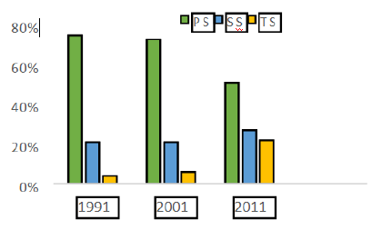
Geo-Eye
Department of Geography & GIS

Department of Geography & GIS

Geo-Eye
Year: 2022, Volume: 11, Issue: 2, Pages: 1-4
Original Article
P Jayashree1,*, V Minutha2, R Ramya2, Yamuna B Raj3
1 Professor, Department of Studies in Geography, University of Mysore, Mysuru, 570006, Karnataka, India
2 Guest Faculty, Department of Studies in Geography, University of Mysore, Mysuru, 570006, Karnataka, India
3 Assistant Professor, Journalism and Mass Communication, St. Philominas College, Mysuru, 570006, Karnataka, India
*Corresponding author email: [email protected]
Received Date:22 May 2022, Accepted Date:17 September 2022
The occupational changes of a nation refer to the percentage of its work force employed in various economic ventures. To put it in other words, articulating the number of the total working populations employed in agriculture and associated activities and the number of them involved in the manufacturing and service sectors can be identified from the occupational changes of the nation. Occupations depend upon the degree of economic development and sophistication of country. Occupational structure influences many aspects of population in a region. The occupational characteristics of population are reflected in the working force, dependency load, employment, and unemployment. Since the region is predominantly dependent upon primary activities especially agriculture and allied activities, engagement of large section of population in this sector was observed, however with the constant socio-economic changes the proportion of population share in the primary activities have been constantly declining. Improved access to education and growing dominance of the service sector have diverted the occupational engagement especially millennial population from primary sector directly to tertiary sector specifically. The occupational engagement in the secondary sector was observed to be least in the region. The concept of occupational changes creates the environmental problems and is studied at present. The situation linked to each other in the type of problems, so it is necessary to investigate the occupational structure in the study area.
Keywords
Occupational, Access, Dominance
© 2022 Jayashree et al. This is an open-access article distributed under the terms of the Creative Commons Attribution License, which permits unrestricted use, distribution, and reproduction in any medium, provided the original author and source are credited.
Published By Bangalore University, Bengaluru, Karnataka
Subscribe now for latest articles and news.